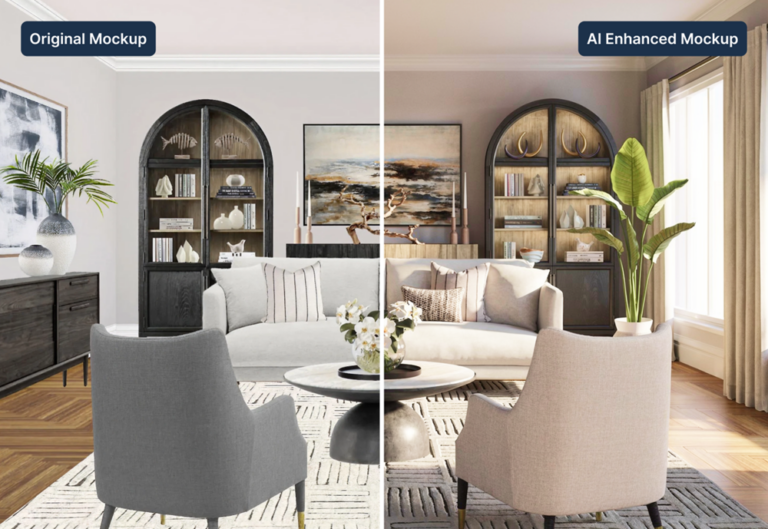Ever felt overwhelmed by the sheer number of software platforms for interior designers out there today? With so many tools to choose from, and many seeming to offer similar features, it can be difficult to settle on the right one.
Coohom and Sketchup are two of the most popular platforms for interior designers, both offering cloud-based design and rendering services. Their feature lists (think mood board creation, virtual walkthroughs, and client collaboration) share certain similarities.
However, they also have some significant differences (floor plan capabilities, price, and online reviews). Let’s dive into those differences together, so you can more easily determine which software would best suit your interior design business.
Table of Contents
What are the main differences between Coohom and SketchUp?
Coohom and SketchUp differ in three main areas: price, ease of use, and architectural features.
- When you first compare pricing, you’ll find that Coohom is significantly cheaper than Sketchup, even compared to Sketchup’s most affordable plan.
- Coohom is easier to use. It has AI features, like one-click floor plan creation, to speed up the design process. Sketchup, on the other hand, comes with a steeper learning curve.
- Sketchup offers architectural capabilities like 2D-floor plans, accurate measurement and dimensional tools, and CAD file compatibility. If you’ll be creating blueprints, Sketchup may be a better fit.
This is just a glance into the differences between Coohom and Sketchup. But let’s take a deeper look.
Coohom VS Sketchup: Features
Coohom offers the following features for interior designers:
- Moodboards
- 3D floor plans (traditional design or one-click options)
- 3D rendering with realistic lights, shadows, and reflections
- Virtual reality walkthroughs
- Product library with over 1 million items (plus the ability to upload your own)
- Upload option for custom product choices
- Premade templates
- Measurement tool
- Section cuts and plan views
- Cloud-based storage and software access
- Branding features
- Team and client collaboration and sharing (via in-software invites and Coohom accounts or project links that do not require account creation)
Sketchup offers a similar list of features, including:
- Moodboards
- 2D and 3D floor plans
- 3D rendering (with VR and AR walkthrough capabilities)
- 3D model warehouse
- Push/Pull Tool for turning 2D shapes into 3D
- Upload option for custom materials, layers, and textures
- Tools for measurements, dimensioning, and annotations
- Section cuts and plan views
- Exterior rendering, including accurate lighting
- Import CAD files for architectural design
- Branding features
- Client collaboration and sharing (via links, file import/export, or Trimble Connect accounts)
Coohom VS Sketchup: Pricing
Coohom is surprisingly affordable, costing just $25 per month or $299 per year. A free account is also available but not for professional use. The free account works well as a trial for professional designers, allowing you to test the software before signing up for a subscription.
SketchUp has three paid plans: Go for $119 per year, Pro for $349 per year, and Studio for $749 per year. You can also use SketchUp for free, but features are limited (no 3D rendering, plug-ins, or commercial use licenses). Free 7-day trials are available for all account levels.
Coohom VS Sketchup: Online Reviews
SketchUp currently has 1300 reviews on Capterra and 1029 on G2. Both sites give the software 4.5 out of 5 stars.
Coohom has fewer reviews, though it still holds a solid ranking: 4.8 stars and 75 reviews on Capterra, 4.6 stars and 77 reviews on G2.
Coohom VS Sketchup: Customer Support
If you choose Sketchup and questions arise, you will most likely find answers on their website. The software’s free online resource hub contains FAQs, troubleshooting guides, and video tutorials. Sketchup Campus also offers complimentary training courses for both free and paid users. If you need additional help, you can turn to Sketchup’s community forum or customer support via email on their website’s “contact us” page.
Coohom offers similar levels of customer support, with an online help center, customer support groups, and a YouTube channel filled with video tutorials. They also provide live chat for your more pressing questions.
Which platform should you choose?
Coohom and Sketchup are both excellent software options for interior designers. If you’re having a hard time choosing between the two, start by answering these three questions:
- Do you want software that is easier to learn (Coohom), or software with more features (Sketchup)?
- Do you want more affordable software (Coohom) or software that can produce more professional deliverables (Sketchup)?
- Do you need architectural features (Sketchup), or is your work solely in the interior design realm (Coohom)?
Next, consider the features of each program. Is there anything that only one offers, that you cannot work without? For example, if you love the idea of one-click floorplans, Coohom may be the right fit for you. Sketch Up may be better if you rely heavily on 2D floor plans.
Ultimately, both Coohom and Sketchup can benefit your interior design business. If you’re unsure, use the free account option (or a free trial of the paid account). You can always try the alternative if you find it’s not meeting your needs.
And if you’re looking for additional interior design business support, check out our guides for finding the best design project management tools or interior design business software.
Frequently asked questions
Both Coohom and Sketchup offer free plans, but they’re not designed for professional use. When you compare the pricing of each platform’s paid plans, you’ll see that Coohom is significantly cheaper than Sketchup.
If Coohom meets all your software needs, the price difference alone makes it worth looking into. Keep in mind, however, that Coohom has some additional costs (such as rendering). These fees won’t raise the price higher than SketchUp’s, but you still may want to budget for them.
Coohom is typically the better choice for interior designers because it’s more affordable and easier to use. It offers the features interior designers rely on (mood boards, floor plans, rendering, walk-throughs, model library, and more). Plus Coohom works great in tandem with DesignFiles, which gives you all the project and client management features you need.
SketchUp offers 2D floor planning, making it the better fit for architects. It also has built-in tools for measurements, dimensioning, and annotations, and is compatible with CAD files. All of these features are essential for creating quality construction blueprints.
Looking for the best interior design platform? Try DesignFiles.


![Top 7 Interior Design Project Management Software [2026 Guide]](https://blog.designfiles.co/wp-content/uploads/2024/06/AdobeStock_215623020-768x512.jpeg)